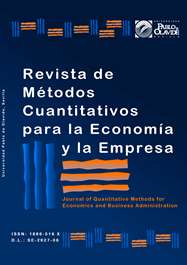Enfoque híbrido simulación-proceso analítico jerárquico: caso de estudio del rediseño de un restaurante
DOI:
https://doi.org/10.46661/revmetodoscuanteconempresa.2192Palabras clave:
Simulación, multicriterio, multiatributo, satisfacción, simulation, multicriteria, multiattribute, satisfactionResumen
La simulación ha demostrado ser una técnica potente y particularmente eficaz para valorar diferentes alternativas de solución de problemas, sin ser necesaria su experimentación real. En particular, resulta útil para la toma de decisiones cuando se desea organizar los puestos de trabajo en una organización donde existan variables que tengan un comportamiento aleatorio e influyan en los resultados. En este trabajo se propone utilizar la simulación discreta para el rediseño y organización del trabajo en un restaurante de comida criolla, el cual presenta problemas en su diseño actual (entre los que destacan: demoras en la atención a los clientes, aumento de los tiempos de espera para sentarse), lo que ha provocado una disminución en las ventas en el último período. Con la simulación se realiza la modelización y evaluación de diferentes alternativas de organización del trabajo y, posteriormente, para el ordenamiento y la selección de la mejor alternativa, se utiliza el enfoque multicriterio en espacios discretos, específicamente el método analítico jerárquico desarrollado por Thomas Saaty, utilizando para ello el software “Jerarquías".
Descargas
Citas
Aragonés, B.P. (1997) “Aproximación a la Toma de Decisiones en Proyectos. Implementación de una metodología multicriterio y multiexperto: PRESS II”, Tesis Doctoral, Universidad Politécnica de Valencia, España.
Aragonés, B.P. (2003) “Técnicas de ayuda a la toma de decisiones en proyectos”, Documento de trabajo. Departamento de Proyectos, Universidad Politécnica de Valencia, 30 p.
Banks, C. et al. (2000) “Discrete-Event System Simulation”, Editorial Prentice Hall, 3ª edición.
Cardona, M.L. (2007) “Aplicación de la Simulación y Modelación Matemática para el estudio de Sistemas de Inventarios”, Tesis de Licenciatura en Ciencias Básicas, Universidad EAFIT, Medellín, Colombia.
Delgado, K.; Mejía, M. (2011) “Aplicación de la simulación discreta para proponer mejoras en los procesos de atención en el área de emergencia de un hospital público”, Industrial Data [en línea] vol. 14, nº1, pp. 47–54; URL: http://hdl.handle.net/123456789/4138
Espinosa, J. (2009) “Gestión de calidad e inocuidad en restauración”, II Convención Internacional Alimentación Saludable para la Comunidad y el Turismo, ACTAC, Varadero, Cuba.
Garza, R.; González, C.; Pérez, I.; Martínez, E. (2012) “Concepción de un procedimiento utilizando herramientas cuantitativas para mejorar el desempeño empresarial”, Revista Ingeniería Industrial, vol. 33, nº 3, pp. 239–248.
Guasch, A.; Pera, M.A.; Casanovas, J.; Figueras, J. (2003) “Modelado y simulación. Aplicación a procesos logísticos de fabricación y servicios”, Ediciones de la Universidad Politécnica de Cataluña, 2ª edición, pp. 187–201.
Heredia, L. (2004) “Jerarquía, Sistema de apoyo a la toma de decisiones”, Trabajo para el Título de Ingeniero en Informática, La Habana, Cuba.
Kelton, W.D.; Law, A.M. (2000) “Simulation Modeling & Analysis”, Editorial Mc Graw Hill, 3ª edición.
Kelton, W.D.; Sadowski R.; Sturrock D. (2009) “Simulation with ARENA”, Editorial Mc Graw Hill Science Engineering, 3ª edición.
Law, A. (2006) “Simulation Modeling & Analysis with expertfit software”. Editorial Mc Graw Hill International, 4ª edición.
Lieberman, G.; Hillier, F. (2006) “Introducción a la Investigación de Operaciones”, Prentice Hall, 8ª edición, México.
Pérez, E. (2011) “Propuestas de organización a partir del rediseño del servicio gastronómico en el restaurante El Palenque”, Trabajo Grado de Ingeniero Industrial, La Habana, Cuba.
Pérez, I. (2001) “Procedimiento para la optimización de experimentos simulados”, Tesis Doctoral, Instituto Superior Politécnico José A. Echevarría, La Habana, Cuba.
Punset, E. (2006) “Adaptarse a la marea”, Editorial ESPASA CALPE.
Rabelo, L. et al. (2005) “Supporting Simulation-Based Decision Making with the use of AHP Analysis”, Proceedings Winter Simulation Conference, Florida, USA.
Ríos, I.D. (2008) “Simulación. Métodos y aplicaciones”, Editorial RA-MA S.A, 2ª edición, España.
Saaty, T.L. (1990) “Decision making for Leaders: the Analitic Herarchy Process for decision in a complex World”, Editorial RWS Publications, University of Pittsburgh, Pittsburgh, USA.
Tabucanon, M. (1988) “Multiple Criteria Decision Making in Industry, Studies in Production and Engineering Economics”, Editorial Elsevier, New York, USA.
Valerie B.; Stewart, T.J. (2002) “Multiple Criteria Decision Analysis: an integrated approach”, Editorial Kluwer Academic Publishers, 2ª edición.
Xu, D. et al. (2012) “A simulation study integrated with analytic hierarchy process (AHP) in an automotive manufacturing”, Simulation, vol. 88, nº 4, pp. 450–463.
Descargas
Publicado
Cómo citar
Número
Sección
Licencia
Derechos de autor 2014 Revista de Métodos Cuantitativos para la Economía y la Empresa

Esta obra está bajo una licencia internacional Creative Commons Atribución-CompartirIgual 4.0.
El envío de un manuscrito a la Revista supone que el trabajo no ha sido publicado anteriormente (excepto en la forma de un abstract o como parte de una tesis), que no está bajo consideración para su publicación en ninguna otra revista o editorial y que, en caso de aceptación, los autores están conforme con la transferencia automática del copyright a la Revista para su publicación y difusión. Los autores retendrán los derechos de autor para usar y compartir su artículo con un uso personal, institucional o con fines docentes; igualmente retiene los derechos de patente, de marca registrada (en caso de que sean aplicables) o derechos morales de autor (incluyendo los datos de investigación).
Los artículos publicados en la Revista están sujetos a la licencia Creative Commons CC-BY-SA de tipo Reconocimiento-CompartirIgual. Se permite el uso comercial de la obra, reconociendo su autoría, y de las posibles obras derivadas, la distribución de las cuales se debe hacer con una licencia igual a la que regula la obra original.
Hasta el volumen 21 se ha estado empleando la versión de licencia CC-BY-SA 3.0 ES y se ha comenzado a usar la versión CC-BY-SA 4.0 desde el volumen 22.










